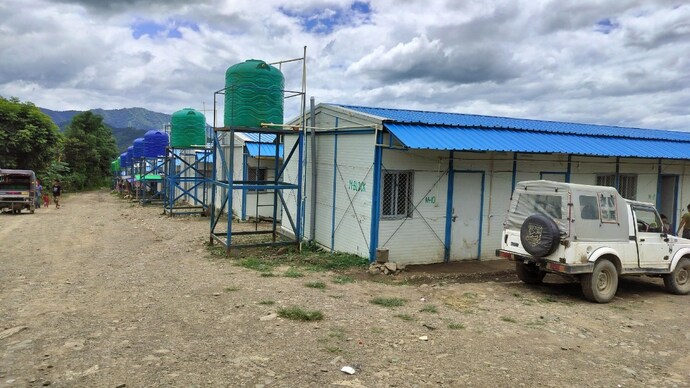Ground report: In restless Manipur, displaced Kukis await return to normalcy
Manipur has borne witness to ethnic violence for the past 16 months. The victims of violence are spread across the valley and the hills, with thousands displaced from their homes. Here's a ground report from one displacement camp.

In Short
- Thousands displaced in Manipur after ethnic violence
- 700 Kukis living in Kangpokpi camp since May 2023
- Lack of amenities adding to hardship faced by the community
Manipur is once again witnessing a surge in violence. And, again, protests are erupting on the streets. Despite efforts by the government and agencies to control the situation, peace remains elusive in the northeastern state. Since the conflict began in Manipur, thousands of people from both communities have been affected.
Victims of violence are spread across the valley and the hills, with thousands displaced from their homes. Many are now living in relief camps or in makeshift houses provided by the central government.
Crossing the valley, India Today TV meets victims of violence who have been displaced from their homes and villages. They are now living in the hilly areas under extremely difficult conditions, marked by pain and trauma.
In the Phaijang hills of Kangpokpi district, nearly 700 displaced Kukis are living in relief camps.
Hohoi and her sister Naiun sing a song sending a message of peace and harmony — perhaps the most needed sentiment at this time. Both express their longing to return to the homes they were forced to leave during the violence.
The Kukis living here left their homes in the last week of May 2023, during the peak of the ethnic conflict, when their village was burned, their houses destroyed, and several vehicles were damaged.
From the foothills and surrounding areas, these Kuki families fled to the hills and sought refuge in schools and relief camps. A few were fortunate to have relatives in the hilly districts, but most were not. They spent months in temporary camps, surviving on food provided by the administration or churches. Eventually, thousands of these displaced people were moved to houses set up in different locations across Kangpokpi and other areas.
When the relief and aid mission started, the central government provided prefabricated houses for the victims in both the valley and the hills. These houses range from 100 to 250 square feet, depending on the size of the family. They include a toilet, washroom, kitchen, and bedroom, with metal sheet rooftops and fibre walls. The administration supplies electricity and water.
In the camp India Today TV team visited, there were around 700 Kukis, including women, children, men, and senior citizens.
A Kuki woman named Momoi, who lived for decades in a house built with blood and sweat, narrates her plight and pain after the violence.
"In May, the violence started. The mob came and burned our houses. Several people were killed, and there was massive firing. We all escaped to save our lives and reached Kangpokpi town, where I have a relative. Many of us were living in schools or relief camps, and from June this year, I got this house. There are children and women in the camps, and we all have the same question — when will the situation return to normal, and when can we go back home?"
There have been 10 infants born in this relief camp alone since their relocation. The numbers would be higher if we accounted for all such relief camps.
In this camp, four people, including children, died due to a lack of basic amenities. Kuki activist Moi says, "Life is too difficult for these displaced families. Four died here — two males and two females, including two kids — due to serious illnesses, as there were no adequate arrangements for treatment. We are completely disconnected from the valley due to the ongoing situation."
Men and young women living in the camps struggle to find work, making it difficult to earn a livelihood. Some women make plastic bags and sell them to meet their needs.
Hinglem Haokip, a teacher, says, "We want to go home. The government must provide us with security. All the help we get in the camp, even food, comes from the government. It's very difficult to live here."
Small children attend local schools, but parents remain uncertain about their future.
Since the violence broke out in Manipur, nearly 41,450 Kukis have been displaced. According to the Kuki Students' Organization, nearly 199 Kukis have died so far, more than 7,000 houses have been burned, and over 200 Kuki villages have been targeted. Many Kukis who died during the conflict are buried in the locality.
A "Wall of Remembrance" has been created by the Committee on Tribal Unity, the apex body of the Kukis, to honour those who have died. Those who died were buried in the village.
In these camps, there is pain, trauma, and concern. Music helps heal the pain, and prayers keep them strong. History has shown that innocent people often bear the brunt of conflict, as is evident from the suffering of both communities in Manipur.

